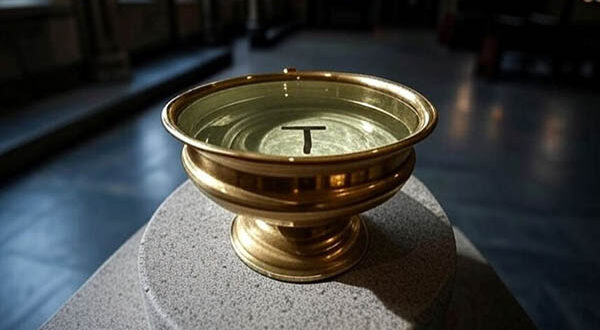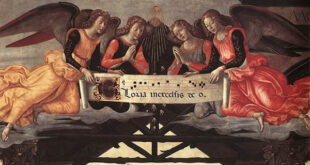An Eschatological Symbol of Protection and Belonging to the Redeemed
Introduction: The Power of Signs in Christian Life
In Catholic tradition, signs and symbols are not mere ritual decorations or empty formulas. They are living expressions of the divine mystery—visible realities that communicate the invisible. Among these signs, there is one that has fallen into oblivion for many faithful, although in its discretion it holds profound spiritual power: the tau letter (τ) that the priest, often almost imperceptibly, traces with holy water over doors, the faithful, or sacred objects.
What does this gesture mean? Where does it come from? Why is it important to rediscover it today, in a world marked by relativism and spiritual confusion? This article aims to take you to the heart of this ancient sign, whose theology is rooted in Scripture, Church history, and the eschatological hope of the redeemed people.
1. Biblical Origin of the Tau Sign: The Seal of the Elect
The first and most powerful mention of the tau (Τ) sign is found in the Old Testament, in the book of the prophet Ezekiel:
“And the Lord said to him: Go through the city, through the midst of Jerusalem, and put a mark on the foreheads of the men who sigh and groan over all the abominations that are committed in it.” (Ezek 9:4)
In the original Hebrew text, the “mark” mentioned is precisely the letter “tav” (ת), which in Paleo-Hebrew form looked like a cross or an “X.” This letter, which corresponds to the tau (Τ) in Greek, was used as a sign of divine protection: those who bore this sign were spared from the punishment that was about to fall upon the city because of its sins.
This passage was interpreted very early by the Fathers of the Church as a prophetic announcement of the sign of the cross, which would later become the central symbol of Christian redemption.
2. The Tau as an Early Christian Symbol
In the first centuries of Christianity, the tau letter became a sign of Christian identity. It was a shorthand way of professing faith in the Crucified One without using words. Christians would draw it in the catacombs, on their belongings, on walls, and even on themselves.
St. Jerome wrote:
“The last letter of the Hebrew alphabet is the tau, which has the form of a cross, and which was placed on the foreheads of the men who sighed and wept.”
(Commentary on Ezekiel, 9:4)
And Tertullian, at the end of the second century, stated that Christians “mark our foreheads with the sign of the cross” (De Corona, 3). Although he does not mention the tau specifically, the gesture is closely related: the tau was already understood as the prototype of the cross.
Thus, the tau, in its most ancient form, became a sign of the redeemed, of those who have been saved by the blood of the Lamb and walk with hope toward eternal life.
3. St. Francis of Assisi and the Spirituality of the Tau
One of the great promoters of the tau symbol was St. Francis of Assisi, who adopted it as his personal spiritual seal. He wrote it in his letters, painted it on the walls of cells, and even signed official documents with it.
For Francis, the tau was not just a letter or a decoration: it was a sign of conversion, poverty, humility, and obedience to the Gospel. It represented the cross that every Christian must carry and, at the same time, the divine protection that accompanies those who live according to the Spirit.
Pope Innocent III, a contemporary of Francis, used the tau in a speech during the Fourth Lateran Council (1215), calling Christians to “mark themselves with the tau” by living a life of holiness. This deeply impacted the Poverello, who from then on adopted it as a seal of belonging to the crucified Christ.
4. The Priest’s Gesture: Tracing the Tau with Holy Water
When a priest blesses with holy water—whether the faithful, a home, or a liturgical object—he often traces a cross in the air, but in specific cases (such as in ancient rites for the consecration of altars or church doors), he uses a tau, a cross without the upper arm, simple and silent, yet deeply symbolic.
This gesture reminds us that we are marked by God’s blessing, that we have been sealed with the Holy Spirit, and that, just as in the passage from Ezekiel, God distinguishes and protects those who cry out for justice and live faithfully.
This invisible trace with holy water is a ritual of belonging, a renewal of Baptism, an actualization of the eschatological seal that reminds us that we belong to Christ.
5. Theological and Eschatological Meaning of the Tau
a) Seal of the Redeemed
The Book of Revelation picks up the theme of the “seal on the forehead”:
“Do not harm the earth or the sea or the trees, until we have sealed the servants of our God on their foreheads.” (Rev 7:3)
The tau, as a cross and symbol of consecration, is a foretaste of that invisible seal borne by the saints. In Christian eschatology, the seal distinguishes the people of God in the midst of the world’s chaos and protects them in the great tribulation.
b) Spiritual Protection
In an age of doctrinal confusion, spiritual warfare, and a secularized world, the tau sign reappears as a shield. Not a magical or superstitious shield, but a call to live marked by faith, conscious that God recognizes His own—those who bear the cross not only on their forehead but also in their soul and deeds.
c) Call to Conversion
The tracing of the tau with holy water is not just a gesture of protection but an invitation to daily conversion. It is a reminder that each Christian must live “sealed” by humility, spiritual poverty, love for truth, and fidelity to the Cross.
6. Practical Applications for the Life of the Faithful
What can a Christian today do with this knowledge?
- Rediscover the sacramental signs. Value holy water; use it with faith when entering your home, starting your day, or protecting your children. Not as a charm, but as a sign of belonging to Christ.
- Trace the tau over yourself. When you pray, make the sign of the cross on your forehead in the form of a tau, with intention, knowing that you are claiming your identity as one of the redeemed.
- Live as one who is sealed. Let your life reflect that seal: be coherent in your faith, reject sin, fight for truth, and be a light in the midst of darkness.
- Teach others about Christian symbols. Teach your children, grandchildren, or catechumens the value of liturgical gestures and how Christianity is not only ideas but an embodiment of mystery in everyday life.
- Ask the priest for this blessing. On special occasions (start of a school year, blessing of a home, spiritual retreat), ask your parish priest to trace over you or your family the sign of the tau with holy water, as a gesture of consecration.
Conclusion: The Return of a Powerful Sign
We live in times that push us to forget our roots, abandon sacred signs, and trivialize what is holy. But God does not forget His own, and His seal remains upon those who, as in the days of Ezekiel, weep and groan for the sin of the world and cling to the Gospel.
The tau is more than a letter: it is the sign of the redeemed, the shield of those who believe, the mark of those journeying toward the heavenly Jerusalem. Recovering it in our spiritual life is not nostalgia: it is active hope, it is living as ones marked by the cross, sealed by love, and consecrated to the Lamb.
“Let no one cause me trouble, for I bear on my body the marks of Jesus.” (Gal 6:17)
When you see that small cross, that ancient and powerful sign, remember who you are and to Whom you belong.






